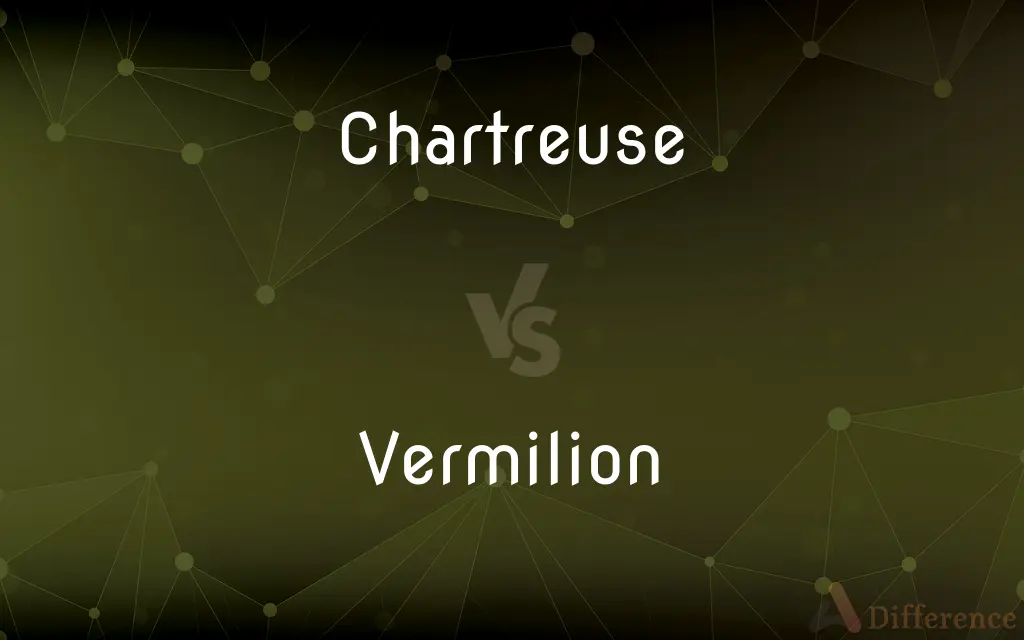Chartreuse vs. Vermilion — What's the Difference?
Edited by Tayyaba Rehman — By Fiza Rafique — Updated on May 5, 2024
Chartreuse is a vibrant shade of green-yellow, known for its vividness and brightness, while vermilion is a brilliant red-orange, often associated with its vivid and intense hue.

Difference Between Chartreuse and Vermilion
Table of Contents
ADVERTISEMENT
Key Differences
Chartreuse is a color that sits between green and yellow, famously named after the French liqueur that exhibits this hue. Whereas, vermilion is a striking shade of red with hints of orange, named for the pigment originally derived from the mineral cinnabar.
In terms of visibility and application, chartreuse is highly visible, making it popular in safety and high-visibility clothing. On the other hand, vermilion has been historically favored in art and decoration, prized for its vivid red pigment that stands out boldly on canvas and in cultural artifacts.
Chartreuse is often associated with spring and freshness, conveying a sense of growth and vitality. Conversely, vermilion often symbolizes strength, passion, and sometimes danger, reflecting its intense and striking appearance.
When used in design, chartreuse can add a lively and energetic touch to graphics and interiors, ideal for spaces aiming to evoke freshness and innovation. Vermilion, however, is frequently chosen to make bold statements, suitable for accent walls or in design elements that aim to capture attention and evoke strong emotions.
In terms of cultural significance, chartreuse is less historically loaded than vermilion but has seen modern adoption in fashion and media for its quirky and unique appeal. Vermilion, however, carries deep historical and cultural significance, especially in Asia where it is used in wedding ceremonies and religious art.
ADVERTISEMENT
Comparison Chart
Hue
Green-yellow
Red-orange
Common Associations
Safety, visibility, spring, freshness
Strength, passion, danger, cultural significance
Use in Design
High-visibility clothing, fresh and lively designs
Bold statements, historical art, accent walls
Cultural Significance
Modern, quirky, less historically significant
Historically rich, significant in ceremonies and religious contexts
Visibility
Highly visible, used for safety
Vivid and intense, used for emphasis
Compare with Definitions
Chartreuse
Associated with freshness.
The chartreuse leaves of the new plants added life to her garden.
Vermilion
Striking and bold.
The vermilion door stood out against the muted colors of the house.
Chartreuse
Bright and vibrant.
He painted the wall chartreuse to brighten the room.
Vermilion
A brilliant red-orange color.
The artist used vermilion to highlight the sunset.
Chartreuse
Modern and quirky.
Her chartreuse accessories added a pop of unexpected color.
Vermilion
Symbolic of passion and danger.
Vermilion is often used to signify strong emotions in literature.
Chartreuse
A shade of green-yellow.
The chartreuse dress was perfect for the spring picnic.
Vermilion
Historically used in art.
Vermilion pigment was prized in Renaissance paintings.
Chartreuse
Visually striking.
The chartreuse safety vests are impossible to miss.
Vermilion
Deep cultural significance.
Vermilion marks are applied during Indian wedding ceremonies.
Chartreuse
A strong to brilliant greenish yellow to moderate or strong yellow green.
Vermilion
Vermilion (sometimes spelled vermillion) is both a brilliant red or scarlet pigment, originally made from the powdered mineral cinnabar, and the corresponding color. It is commonly used in Hindu culture, primarily by women, and was widely used in the art and decoration of Ancient Rome, in the illuminated manuscripts of the Middle Ages, in the paintings of the Renaissance, and in the art and lacquerware of China.
Chartreuse
A yellow or green liqueur made by Carthusian monks.
Vermilion
A brilliant red pigment made from mercury sulphide (cinnabar).
Chartreuse
(color) A greenish-yellow color.
Vermilion
A vivid red to reddish orange. Also called Chinese red, cinnabar.
Chartreuse
(arts) A kind of enamelled pottery.
Vermilion
See mercuric sulfide.
Chartreuse
(cooking) A French dish of vegetables (and sometimes meat) wrapped tightly in a decorative layer of salad or vegetable leaves and cooked in a dome-shaped mould.
Vermilion
Of a vivid red to reddish orange.
Chartreuse
Of a bright yellowish-green colour.
Vermilion
To color or dye (something) in the hue vermilion.
Chartreuse
A Carthusian monastery; esp. La Grande Chartreuse, mother house of the order, in the mountains near Grenoble, France.
Vermilion
A vivid red synthetic pigment made of mercury sulfide, cinnabar.
Chartreuse
An alcoholic cordial, distilled from aromatic herbs; - made at La Grande Chartreuse.
Vermilion
A bright orange-red colour.
Chartreuse
Aromatic green or yellow liqueur flavored with orange peel and hyssop and peppermint; made at monastery near Grenoble, France
Vermilion
A type of red dye worn in the parting of the hair by married Hindu women.
Chartreuse
A shade of green tinged with yellow
Vermilion
The red skin of the lips or its border with the skin of the face.
Chartreuse
Having the yellowish green color of Chartreuse liqueur
Vermilion
(obsolete) The kermes or cochineal insect.
Vermilion
(obsolete) The cochineal dye made from this insect.
Vermilion
Having a brilliant red colour.
Vermilion
Having the color of the vermilion dye.
Vermilion
(transitive) To color or paint vermilion.
Vermilion
A bright red pigment consisting of mercuric sulphide, obtained either from the mineral cinnabar or artificially. It has a fine red color, and is much used in coloring sealing wax, in printing, etc.
Vermilion
Hence, a red color like the pigment; a lively and brilliant red; as, cheeks of vermilion.
Vermilion
To color with vermilion, or as if with vermilion; to dye red; to cover with a delicate red.
Vermilion
A variable color that is vivid red but sometimes with an orange tinge
Vermilion
Color vermilion
Vermilion
Of a vivid red to reddish-orange color
Common Curiosities
What is the origin of the color names chartreuse and vermilion?
Chartreuse is named after a French liqueur reflecting this color, while vermilion comes from the pigment made from the mineral cinnabar.
What do the colors chartreuse and vermilion symbolize?
Chartreuse symbolizes freshness and vitality, and vermilion represents passion, strength, and sometimes danger.
What is the best setting to use vermilion in decorating?
Vermilion works best in settings where a bold statement or focal point is desired.
Where is chartreuse commonly used?
Chartreuse is used in safety gear, fashion, and anywhere high visibility is desired.
How are the uses of chartreuse and vermilion different in interior design?
Chartreuse is used for its energizing quality and freshness, while vermilion is chosen for bold, dramatic accents.
What are practical tips for decorating with chartreuse?
Use chartreuse in small doses or in areas where you want to stimulate energy and positivity.
Can vermilion be used in modern design?
Yes, vermilion can be effectively used in modern design to create focal points and add vibrancy.
How do the meanings of chartreuse and vermilion reflect their use in ceremonies?
While chartreuse is less commonly used in ceremonies, vermilion’s use in religious and traditional ceremonies underscores its deep cultural importance.
Which color would be more suitable for a visibility vest?
Chartreuse, due to its high visibility, is more suitable for safety and visibility vests.
Why is vermilion significant in art?
Vermilion has been a valued pigment in art for its bright, enduring red color.
What emotions might chartreuse evoke in a viewer?
Chartreuse often evokes feelings of liveliness, energy, and innovation.
Why might vermilion be considered a powerful color?
Vermilion’s intensity and historical significance as a pigment make it powerful in both visual and cultural contexts.
What makes chartreuse a popular choice in fashion?
Its unique and vivid hue makes chartreuse a popular choice for those wanting to make a fresh, bold statement.
How do cultural perceptions of chartreuse and vermilion differ?
Chartreuse is seen as modern and somewhat playful, while vermilion carries traditional and sometimes sacred connotations.
What should be considered when choosing vermilion for artwork?
Consider the emotional impact and the complementary colors to balance its intensity in artwork.
Share Your Discovery

Previous Comparison
Melody vs. Rhythm
Next Comparison
Oxherd vs. CowherdAuthor Spotlight
Written by
Fiza RafiqueFiza Rafique is a skilled content writer at AskDifference.com, where she meticulously refines and enhances written pieces. Drawing from her vast editorial expertise, Fiza ensures clarity, accuracy, and precision in every article. Passionate about language, she continually seeks to elevate the quality of content for readers worldwide.
Edited by
Tayyaba RehmanTayyaba Rehman is a distinguished writer, currently serving as a primary contributor to askdifference.com. As a researcher in semantics and etymology, Tayyaba's passion for the complexity of languages and their distinctions has found a perfect home on the platform. Tayyaba delves into the intricacies of language, distinguishing between commonly confused words and phrases, thereby providing clarity for readers worldwide.
















































